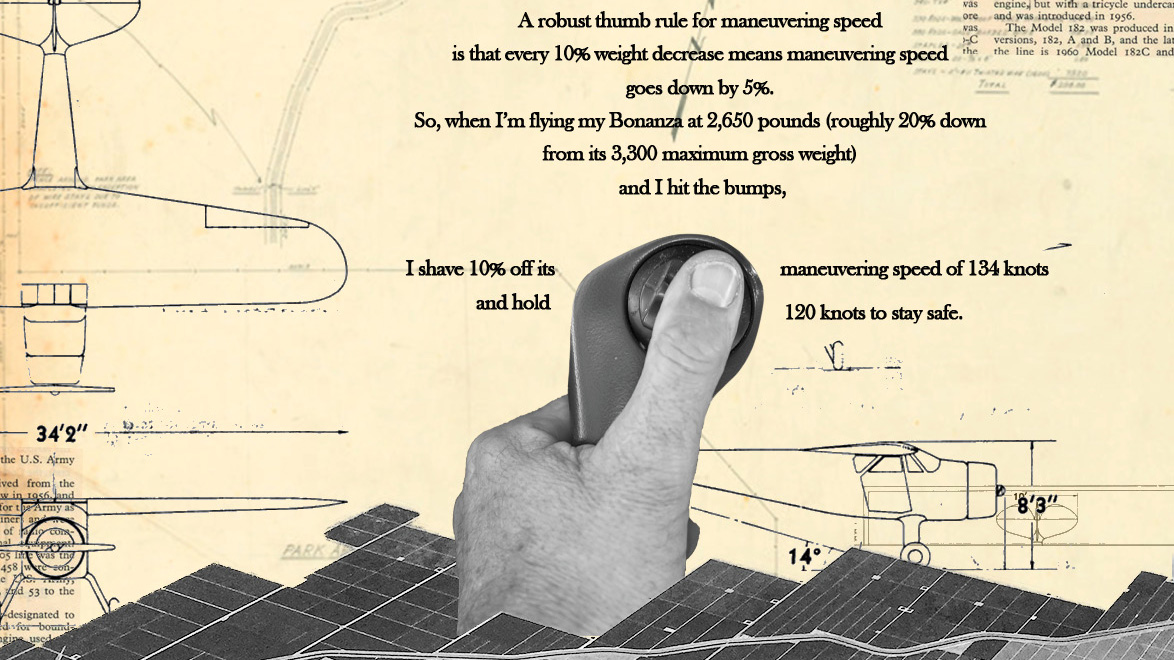Rules of thumb to avoid
Practical experience versus what ‘they’ say

It’s an easy procedure that saves me the humiliation of making a mistake doing “public math.” My friends seem to think having researched in an abstract mathematical field like geometric topology means I can calculate an 18-percent tip in my head, but they are wrong. And having a doctorate in math only increases that pressure.
One of my favorite aviation rules of thumb allows me to ballpark maneuvering speed for an airplane when it’s flown below maximum gross weight. If just one maneuvering speed is published in the manual, then it’s given for the airplane at maximum gross weight, and that figure is often somewhere on the instrument panel. Maneuvering speed is a terrific go-to airspeed in turbulence, as it provides a margin over stall but should also prevent the structural damage that such gusts can cause if the airplane flies too fast. But unless you take off over gross (and I strongly suggest you don’t), the value on your panel isn’t the one you’ll use. Maneuvering speed decreases as weight does, so you’ll need to slow down even more as the flight progresses and fuel is burned.The speed for which you should shoot is actually √(w⁄wmg)VA, a computation that makes a restaurant trip seem like child’s play. A robust rule of thumb is that every 10 percent weight decrease means maneuvering speed goes down by 5 percent. So, when I’m flying my Beechcraft Bonanza at 2,650 pounds (roughly 20 percent down from its 3,300-pound maximum gross weight) and I hit the bumps, I shave 10 percent off the maneuvering speed of 134 knots and hold 120 knots to stay safe.
Unfortunately, for every good rule of thumb I hear a few bad ones. Best glide airspeed seems to provide ample fodder for them to sprout, and, with the help of the internet, to grow. Upon engine failure, it’s important to target best glide airspeed to increase the likelihood that we’ll be able to reach terrain favorable enough for a positive ending to the flight. Flying too slow or too fast means the aircraft won’t travel as far. Such a scenario is arguably more stressful than public math, so rules of thumb abound. I’m sure they are well-meaning, but some are misguided and even dangerous. Here are some of the rules to avoid:
Avoid: “Dial the trim wheel all the way back to full nose-up trim.”
The idea is that doing so will result in approximately the best glide airspeed, but this is completely unfounded. I can find no regulation for aircraft certification that full nose-up trim is associated with the gliding characteristics of the aircraft. In my Cessna 152, trimming full nose up gave me a value slower than best glide airspeed, although not too far off, but doing so in my Beechcraft Bonanza gave me way too slow an airspeed. This advice is especially dangerous for engine failure after takeoff when we might be holding an airspeed below best glide airspeed, and it’s important to push forward on the control column to avoid a stall. Reaching first for the trim wheel could be disastrous. We should use trim to relieve control pressures, not as a primary form of aircraft control.
Avoid: “Look out the side and make the wing level with the horizon.”
There is no reason why, on any given aircraft, a wing that is parallel to the horizon in an engine-out situation will give rise to best glide airspeed. Furthermore, if you can remember to stare out the side window long enough to achieve and maintain this attitude, you have the wherewithal to look at the airspeed indicator, pitch for best glide airspeed, and trim to reduce the pressure needed to sustain that condition.
Avoid: “Average VX and VY for best glide airspeed.”
The FAA publication Best Glide Speed and Distance says best glide airspeed provides the most distance per unit of altitude lost and, “on most airplanes, it will be roughly halfway between VX (best angle of climb speed) and VY (best rate of climb speed).” These airspeeds are computed from a drag polar constructed by the manufacturer during flight testing (a graph of climb rate vs. airspeed for a given power setting), the curve corresponding to VX and VY involves an operational powerplant, and this is not the case for gliding flight. The three airspeeds VX, VY, and VBG for my Bonanza are 76 knots, 96 knots, and 105 knots respectively. Averaging VX and VY would give me about 86 knots, or almost 20 knots slower than the aircraft’s actual best glide speed.
If you don’t remember your best glide airspeed, locate it in your pilot’s operating handbook, memorize it, and put it on your checklist for backup. If you have the time to fine-tune your response during an engine-failure scenario, understand that best glide airspeed changes with factors such as aircraft weight and atmospheric conditions. Factors that improve aircraft performance (reduced weight, tailwinds, updrafts) mean we can afford to fly a little slower than the published speed, and those that hurt performance (headwinds, downdrafts) mean we should fly faster to maximize the glide. (See “Coming Up Short: Your Best Glide Probably Isn’t,” September 2018 AOPA Pilot.)
Rules of thumb are meant to simplify complex procedures and provide dependable results. Not only are the rules above unfounded, but none makes addressing an engine failure scenario any simpler than setting an appropriate airspeed and using the elevator trim to relieve control pressures.
A good rule of thumb can help during a stressful situation. But when we hear of a new rule, it’s important to evaluate it with a critical eye to ensure it’s both effective and helpful.


